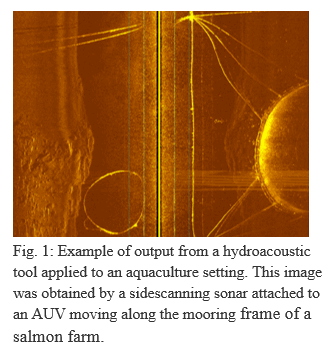HYDROACOUSTIC TOOLS IN SALMON AQUACULTURE AND THE CASE OF FEEDING
Introduction
A wide range of hydroacoustic tools are used in ocean science and the marine industries. Hydroacoustic Doppler instruments, such as current profilers or single point sensors, are widely used to monitor water currents and waves, echo sounders and imaging sonars are applied to locate fish schools for capture fisheries and assessing wild stocks, while telemetry systems may be used to monitor the fish in recreational fishing areas such as salmon rivers. Furthermore, an increasing number of additional applications for hydroacoustics are emerging from the marine industries, including underwater communication networks and navigational tools for underwater vehicles. A discussion of available tools and their potential application within aquaculture is required to obtain an overview of which instruments may be relevant for the industry, and how these can be applied to improve salmon production.
Materials and method
Datasets from a range of different experiments using hydroacoustic technologies will be presented. This will include data from sonar systems (e.g. Biosonics, Norbit), online telemetry systems (e.g. Thelma Biotel), and navigation systems such as LBL and USBL. While much of this new data (see Fig. 1 for an example of such data) has been recently generated in full scale trials at industrial scale salmon farming sites at Aquaculture Engineering (ACE) , datasets obtained at other applications will be used to provide a wider context. This will illustrate the potential of hydroacoustics beyond what has previously been tested at fish farms either through research experiments or in commercial farm management.
Discussion
The presented datasets will be discussed with respect to potential applications of hydroacoustic tools in salmon farming. This will include evaluations on whether data obtained from such tools can be used to achieve a higher degree of automation in daily operation at fish farms. All discussions will be conducted in light of central aspects in fish farming such as growth monitoring and analysis, operational use on underwater vehicles, cage deformation monitoring and feeding. A specific case-study aimed at feeding will investigate whether different instruments, which provide a wide range of data on the cage-fish-environment system, could be used as a basis for developing future feeding methods.
